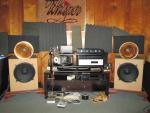Michele,
Good question..
The "sound" difference is really related to the cost ? Yes but not a linear scale and it will depend on other things. What active crossover and amps are you using for example.
If you have expensive amps etc spend accordingly on your crossover to maximise retrieval and transparency of sonic details.
I mean, if I use the AUDIOCAP, the difference will be really "there", or I'll be "biased" by the cost, and could obtain the same result with Clarity cap (or similar products)? I have not used the Audiocaps and I would be careful about what capacitors I used in the 4430. You do not want anything overly bright on the compression drivers. Each brand will have a slightly different sonic signature. Have a look at the Sonicap web page and zip Jeff an email, he is very experienced with capacitor selections
If I use these high-grade capacitors (Audiocap or Auricap) should I still use the bypass capacitors ? No no necessarily , I never bypassed or charge coupled my Hovland 4430 network or Auricaps. And with Clarity cap ? Its a value for money option, I am not saying its the best or the worst. They are a good entry point but they are not a Hovland for example.
My suggestion would be set a budget. and perhaps look at the Auricaps, or the Hovlands as they are not bright like some West Coast film foil capacitors. The Hovlands worked supremely well with that network and the drivers from my own experience. I recall thinking wow, that was expensive but it transformed the 2344 horn into a hi end device.
If on a buget consider or build a Solen/bypassed charge - coupled network.
Pm me details of your system , active crossover etc.
Don't waste time or effort on budget line capacitors, whats in there is probably better.
Hope this helps



 Reply With Quote
Reply With Quote

